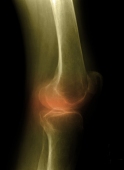Measures of structural joint damage relate to clinical prognosis in the following year
MONDAY, March 9, 2015 (HealthDay News) — Structural joint damage measured with magnetic resonance imaging (MRI) can predict knee replacement in the following year, according to research published in the March issue of Radiology.
Frank W. Roemer, M.D., of Boston University, and colleagues analyzed data drawn from 4,796 participants in the Osteoarthritis Initiative, a longitudinal observational study of individuals who have, or are at risk for, knee osteoarthritis. During five years of follow-up, 199 knees underwent replacement (cases) and were matched with 199 knees that did not undergo replacement (controls). The association between MRI-based measures of structural joint damage and knee replacement during the following year was assessed.
The researchers found that the following MRI-based measures significantly increased risk of knee replacement during the following year: two or more subregions with severe cartilage loss (odds ratio [OR], 16.5; 95 percent confidence interval [CI], 3.96 to 68.76), more than two subregions with bone marrow lesions (OR, 4.00; 95 percent CI, 1.75 to 9.16), medial meniscal maceration (OR, 1.84; 95 percent CI, 1.13 to 2.99), effusion (OR, 4.75; 95 percent CI, 2.55 to 8.85), and synovitis (OR, 2.17; 95 percent CI, 1.33 to 3.56). Meniscal extrusion did not predict knee replacement during the following year (OR, 1.00; 95 percent CI, 0.60 to 1.67).
“Apart from meniscal extrusion, all features of tissue abnormalities at MR imaging were related to clinical prognosis and could be used to predict knee replacement in the following year,” the authors write.
The study was partly funded by pharmaceutical companies. Several authors disclosed financial ties to biomedical, pharmaceutical, and medical device/imaging companies.
Full Text (subscription or payment may be required)
Copyright © 2015 HealthDay. All rights reserved.








